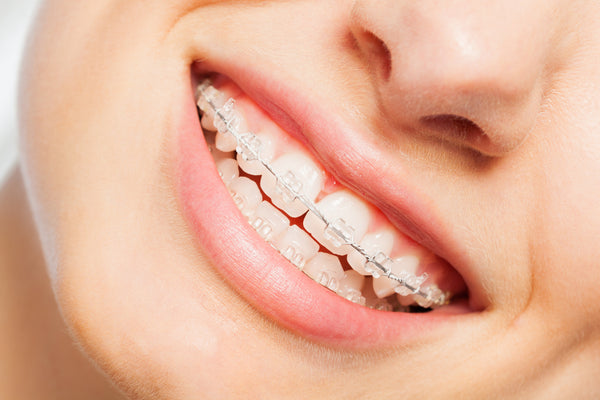
There are many options when it comes to orthodontic treatment today. Invisible braces, fixed braces, lingual and functional braces, all of which have a specific use depending on the case and severity of correction. For some, the corrections needed may only be mild, in these cases, aligners can be used such as Invisalign. In other cases, where the treatment needs to be more robust, a more traditional approach is needed such as fixed metal braces.
For some, the thought of having fixed metal braces, where your orthodontist can adjust and guide tooth movement more diligently, is one of dread. It is understandable not to want to have your mouth full of visible metal brackets and wires, especially for teenagers and young adults who undoubtedly feel self-conscious. The good news is that ceramic braces are an excellent alternative for this very reason.
Let’s look at how metal and ceramic braces can help with specific dental problems and weigh up which is more suitable in five key areas.
What are the Differences Between Ceramic and Metal Braces?
Both metal and ceramic braces use a similar design to provide corrections, the main and most obvious difference being the material the brackets are made from.
Metal braces use brackets that are made from medical-grade, stainless steel, connected with a metal archwire which helps to control tooth movement. Metal braces are extremely durable, the obvious downside being they are very visible against the white of your teeth.
Ceramic braces are made from polycrystalline alumina that can either be clear or the same colour as your teeth. They are also connected by a flexible metal archwire which can be made in a lighter colour that matches your brackets. Ceramic braces are also more prone to staining due to the light colour, however, they are a much more desirable option as they can be almost invisible.
The Competition: Ceramic Braces vs. Metal Braces
We have chosen five key areas of importance when choosing the right braces for you, with the intention of seeing how both metal and ceramic braces fair up. First up:
Appearance
The most noticeable difference between ceramic and metal braces is their appearance. Metal braces, made of stainless-steel brackets and wires are highly visible and can be a prominent feature of your smile. Ceramic braces, however, are designed to be less conspicuous. They use clear or tooth-coloured brackets and wires that blend in with your teeth, making them much less noticeable.
Winner: Ceramic Braces – For those concerned about aesthetics, ceramic braces offer a more discreet option.
Durability
Metal braces are known for their durability. They can withstand a lot of pressure and are less likely to break or chip compared to ceramic braces. Ceramic braces, while still strong, are more prone to damage and the ceramic brackets can chip or crack, especially if you consume hard or sticky foods or engage in activities that increase the risk of impact. While metal braces are more durable, the downside is that they are more likely to cause discomfort just to the nature of the material.
Winner: Metal Braces – If you have an active lifestyle and therefore prioritise durability, metal braces are a better choice.
Maintenance
Both ceramic and metal braces require regular maintenance, including adjustments by your orthodontist. However, ceramic braces may require more attention in terms of keeping them clean and free from stains. The clear or tooth-coloured components can be susceptible to discolouration from certain foods and drinks like coffee, tea, and red wine.
Winner: Metal Braces – Metal braces are generally easier to maintain, as they are less prone to staining.
Comfort
Comfort is an essential factor when choosing braces and many patients worry that metal braces will be uncomfortable due to the brackets and wires, but modern advancements have made them more comfortable than ever. They do, however, continue to be made from stainless steel, which compared to ceramic braces, made from non-abrasive, high-quality ceramic materials, are less likely to irritate gums or the inside of your cheeks.
Winner: Ceramic Braces – For comfort, both options are suitable, but ceramic braces may have a slight edge due to their core materials.
Cost
Generally, metal braces are more affordable than ceramic braces. Ceramic braces are a bit more expensive due to their aesthetic appeal and the high-quality materials used in their construction. It is also possible that achieving the desired results may take longer with ceramic braces, which has a natural impact on cost.
Winner: Metal Braces – If budget constraints are a concern, metal braces are the more cost-effective option.
The Decider: Which Option is Best Suited for You?
If we were to add up the results from the five categories we have covered, then metal braces are the clear winner. Durability, maintenance, and cost are all factors which make metal braces both effective at achieving the desired corrections and the upkeep and general maintenance of having braces, but they are also cheaper.
However, for some, appearance is the be-all, end-all factor in choosing braces, and just due to this factor alone makes ceramic braces a better option, even with an increase in cost in mind.
In order to truly understand what is right for your teeth and treatment, come and speak to an Orthodontist in Oldham today.
Speak to a Specialist Led Orthodontist in Oldham
Choosing the right option for you can only be done through knowledge, understanding and support, and our team here at Oldham Orthodontics can provide just that. We are an expert orthodontic practice in Oldham offering a wide range of the latest orthodontic treatments to help children and adults gain beautiful straight smiles.
If you would like to speak to us about what you want out of orthodontic treatment, then contact us today for a free consultation.
